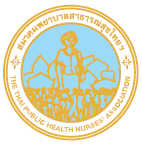Management of Patient Care for Chronic Non-Communicable Diseases in Multicultural Communities Along the Northern Border of Thailand
Keywords:
Care management, Non-communicable Disease, Multicultural communityAbstract
Chronic non-communicable disease is a significant problem that challenges health personnel to manage care with utmost effectiveness. This descriptive research aimed to study the management of patient care for chronic non-communicable diseases in multicultural communities along the northern border of Thailand. It focused on cardiovascular disease, hypertension, and diabetes mellitus. The research surveyed care providers’ perceptions of management of patient care of chronic non-communicable diseases through an in-depth interview of 10 administers of health service. A focus group sample included 21 care managers, 20 community health leaders, and some patients with chronic disease. The total sample of the perception study was 39 health care providers. Research tools were 1) in-depth interview guideline, 2) focus group guideline, and 3) self-report of Assessment of Chronic Illness Care (ACIC Thai version). The content validity index and Cronbach alpha coefficient of self-report was .99. The data was analyzed by content analysis and descriptive statistics. Assessment of care management for patients with chronic non-communicable disease in multicultural community was based on 6 components of Wagner’s Chronic Care Model. Strategies were management as twin or paralleled villages of Thai and migrant communities which emphasized three groups at three ages: children, middle-age adults, elders; and four principle pillars: school, temple, district health promotion hospital, and local administrative organization. Care providers perceived care management in the domains of organization of the healthcare delivery system, community linkages, practical level (self-management support, decision support, delivery system design, clinical information systems), and integration of chronic care model components to be at the good level. Health personnel should apply study results to improve the quality of the management of patient care for those with chronic non-communicable disease in the community.
References
WHO. Global burden of noncommunicable diseases, World Health Organization, South-East Asia Region. 2012 a. [cited 2014 Oct 15]. Available from: http://www.searo.who.int/en/section1174/section 1459.htm.
Bureau of Policy and Strategy, Office of the Permanent Secretary. Implementation of chronic disease prevention and control of Thailand under the Tenth National Economic and Social Development Plan: Success or failure. NewsHealth, 2010;3;7: 15-19.
WHO. Health and economic burden of NCDs in the region, World Health Organization, South-East Asia Region. 2012 b. [cited 2014 Oct 15]. Available at http://www.searo.who.int/en/section1174/section 1459.htm.
WHO. Noncommunicable diseases—Time for action, World Health Organization, South-East Asia Region. 2012 c. [cited 2014 Oct 15]. Available at http://www.searo.who.int/en/section1174/section 1459.htm.
Plianbangchang S. Message from the Regional Director, World Health Organization, South-East Asia Region. 2012. [cited 2015 April 7]. Available at http://www.searo.who.int/en/section 1174/section 1459.htm.
Cooney N. (Ed.). Literature review: The current situation and care model of non-communicable diseases. Bangkok: Art Qualify; 2014.
Wagner EH., Austin BT, Davis C, Hondmarsh, M, Schaefer, J, Bonomi A. Improving chronic illness care: Translating evidence into action; 2012. [cited 2014 Sep 21]. Available at http://content.healthaffairs.org/content/20/6/64.long.
Tooprakai D, Gomutbutra P, Sakarinkhul P. The study of Home Service Care Model and quality of care assessment of stroke patients in the upper part of North. PCFM, 2009;3(2): 1-35.
Ruttawongsa A, Kongtaln O. Development of the Community–based Continuing Care Management Guideline for stroke survivors of Kosumpisai Hospital and it’s network. Graduate Research Conference in 2012; Khon Kaen University. Khon Kaen: Khon Kaen University; 2012.
Danyuthasilpe C, Surintorn K. Caring for elderly with chronic illness in the community. Journal of Public Health, 2013;Special Issue on the 84th Birthday Celebration of King Bhumibol Adulyadej: 99-108.
Gomutbutra P, Aramrat A, Sattapansri W, Chutima S, Tooprakai D, Sakarinkul P, Sangkhasilapin Y. Reliability and validity of a Thai version of Assessment of Chronic Illness Care (ACIC). J Med Assoc Thai, 2012;95(8): 1-9.
Kadu MK, Stolee P. Facilitators and barriers of implementing the chronic care model in primary care: A systematic review. BMC Family Practice, 2015;16;12. [cited 2016 Nov 19]. Available at http://bmcfampract.biomedcentral.com/articles/10.1186/ s12875-014-0219-0 doi: 10.1186/s12875-014-0219-0.
Stellefson M, Dipnarine K, Stopka C. The chronic care model and diabetes management in US primary care settings: A systematic review. Preventing chronic disease: Public health research, practice, and policy, 2013;10; February 21: 1-35.
Gomutbutra P. Chronic care. Clinical Journal, 2008; 280 (April). [cited 2016 Feb 26]. Available at http://www.doctor.or.th/ node/7036.
Cherngyooth K, Oba N, Laksomya T. Caring outcomes of patients with type 2 diabetes by contracting unit of primary care, Naresuan University Hospital. Journal of Nursing and Health Sciences, 2012;6(2): 110-121.
Silpasuwan P, Viwatwongkasem C, Kittipichai W, Auemaneekul N, Sativipawee P, Sujirarat D, …Hunglang S. Data analysis and summarization the surveillance, prevention, and control activities of chronic diseases of Thailand organizations in 2008-2012. [cited 2017 March 10]. Available at http://thaincd.com/document/file/download/knowledge/NCD-ebook211013.pdf.
Downloads
Published
How to Cite
Issue
Section
License
บทความที่ตีพิมพ์และแผนภูมิรูปภาพถือเป็นลิขสิทธิ์ของวารสารพยาบาลสาธารณสุข (Thai Public Health Nurses Association)







